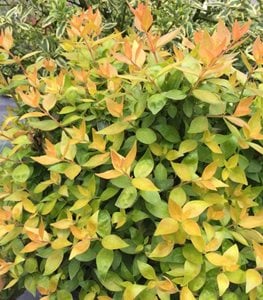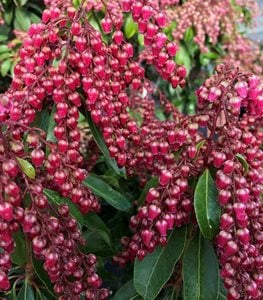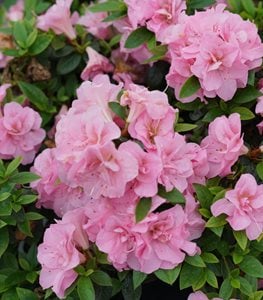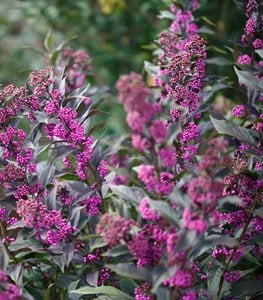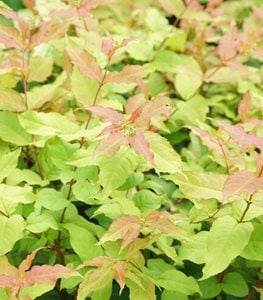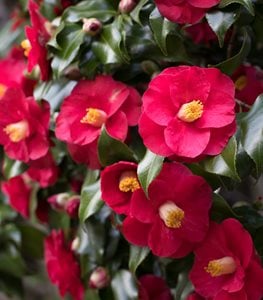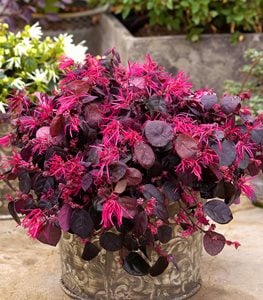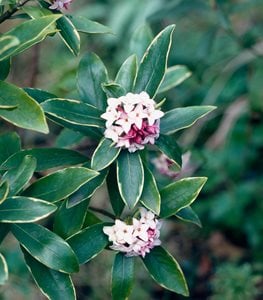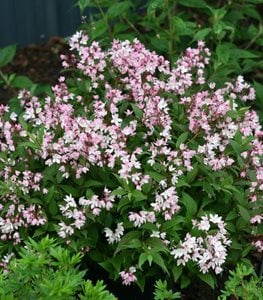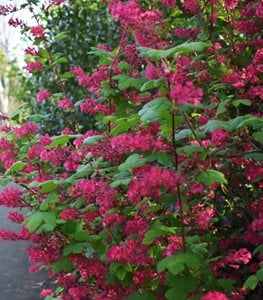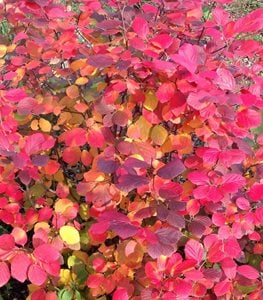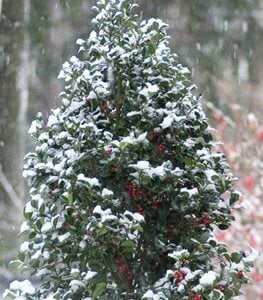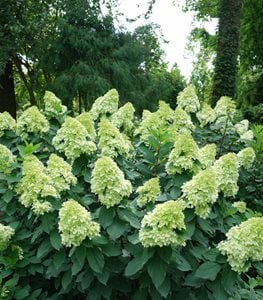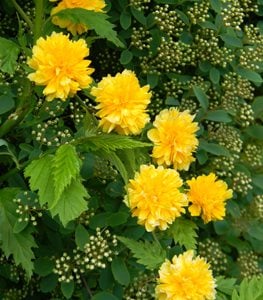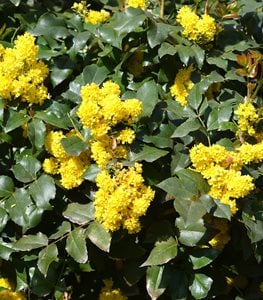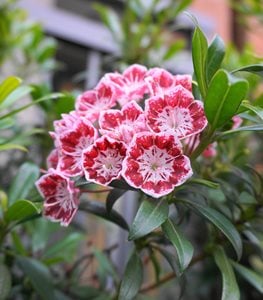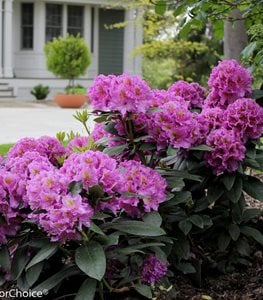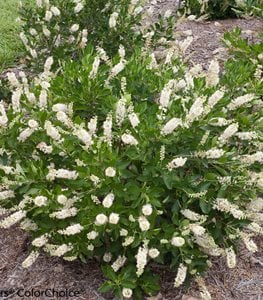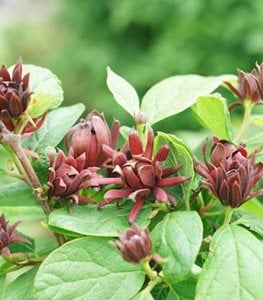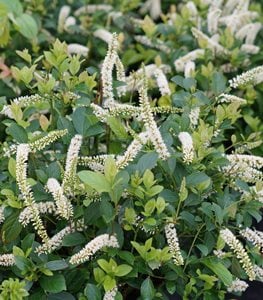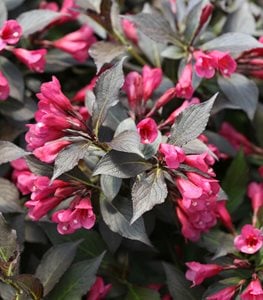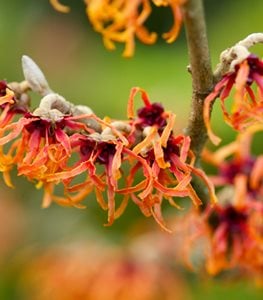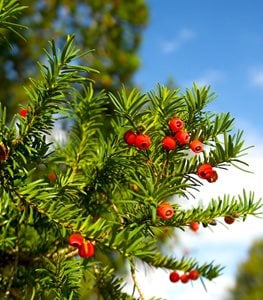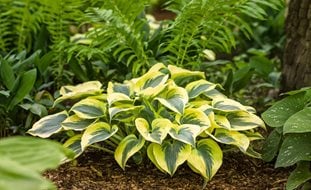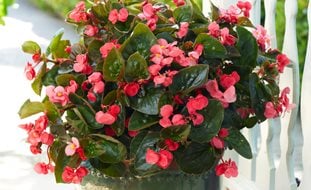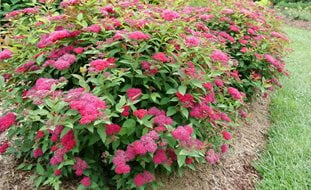24 Shrubs for Shade
Beautify your yard with these reliable shade-tolerant shrubsShady areas can present a challenge to gardeners, as many plants do poorly when there’s too little light. Fortunately, there are many types of plants including shade-loving shrubs that can tolerate or even thrive in low-light conditions. By choosing the right plants, you can create a lush shady haven in your yard.
Even plants that can tolerate shade need some direct light to perform well. It’s essential to know what kind of shade you have (see more below) before you choose and site your plants. Here are some of the best shrubs for shade gardens, along with tips on how to use them in your landscape.
ABELIA (Abelia spp.)
Funshine® (Abelia grandiflora)
Zones: 4-11, depending on the variety
Exposure: Full sun to partial shade
Growth habit: Upright, arching, or spreading habit
Height/Spread: 2 to 10 feet tall, 2 to 8 feet wide
Bloom time: Spring to fall
One of the best shade-tolerant shrubs, abelia is an underutilized landscape plant that is virtually carefree and tolerant of a wide range of growing conditions. Glossy deciduous foliage comes in various colors, with small tubular flowers that bloom over an exceptionally long time. Use in foundation plantings, borders, and beds. Foliage color and bloom is best in full sun, but plants can tolerate moderate shade. Varieties such as Funshine®, 'Confetti', and 'Kaleidoscope' are more shade tolerant due to their lighter or variegated foliage. Learn more about growing abelia shrubs.
ANDROMEDA (Pieris japonica)
Interstella® (Pieris japonica)
Zones: 5-8
Exposure: Full sun to partial shade
Growth habit: Upright bushy habit
Height/Spread: 3 to 12 feet tall, 3 to 8 feet wide, depending on the variety
Bloom time: Late winter to early spring
Also known as Japanese pieris and lily-of-the-valley shrub, andromeda is a broadleaf evergreen with reddish-bronze new growth, bead-like buds that provide winter interest, and showy clusters of fragrant white, pink, or red flowers that resemble lily-of-the-valley. These slow-growing shrubs add year-round color to woodland borders and foundation plantings. Plants prefer at least 6 hours of direct sun in colder climates, and 2 to 6 hours of sun in warmer regions, with protection from hot afternoon sun. Learn more about growing andromeda shrubs.
AZALEA (Rhododendron spp.)
Perfecto Mundo® Double Pink reblooming azalea
Zones: 6-9, with some deciduous varieties hardy to Zones 3-5
Exposure: Full sun to partial shade, protect from hot afternoon sun in warmer regions
Growth habit: Upright bushy, spreading, or ground cover habit
Height/Spread: 1 to 20 feet tall, 2 to 20 feet wide, depending on variety
Bloom time: Early spring to summer, with some reblooming in summer and fall
Azaleas are grown for the attractive flowers that come in a wide range of colors. There are two types of azaleas, broadleaf evergreens and hardy deciduous shrubs. Use this versatile shrub in woodland borders, foundation plantings, containers, as hedging, or as a background plant. Plants prefer more sun in northern climates and protection from hot afternoon sun in warmer regions. Learn more about growing azalea shrubs.
BEAUTYBERRY (Callicarpa spp.)
Pearl Glam® beautyberry
Zones: 5-10, depending on the variety
Exposure: Full sun to partial shade
Growth habit: Mounding or arching habit
Height/Spread: 3 to 8 feet tall and wide
Bloom time: Late spring to summer; flowers are inconspicuous
Beautyberry is grown for the abundant clusters of purple or white berries that appear from late summer into fall. The brightly colored fruit, which sometimes persists into winter, is a source of food for songbirds and other wildlife. Site this deciduous shrub in a mixed border, natural area or mass along a slope. Plants produce more berries in full sun, but can tolerate partial shade. Learn more about growing beautyberry shrubs.
BUSH HONEYSUCKLE (Diervilla spp.)
Kodiak® Fresh™ diervilla
Zones: 3-7
Exposure: Full sun to partial shade
Growth habit: Bushy spreading habit
Height/Spread: 2 to 4 feet tall, 2 to 5 feet wide
Bloom time: Summer
Suitable for colder climates, bush honeysuckle is a hardy deciduous shrub with clusters of yellow or orange trumpet-shaped flowers that resemble true honeysuckle. New foliage is coppery bronze, fading to green before turning brilliant shades of yellow, orange, and red in fall. Mass along a slope or plant as a hedgerow in a native garden to provide food and shelter for wildlife. Plants are tolerant of a wide range of growing and light conditions, from full sun to partial shade. Learn more about growing diervilla shrubs.
CAMELLIA (Camellia spp.)
Zones: 7-10
Exposure: Partial shade
Growth habit: Upright bushy habit
Height/Spread: 2 to 20 feet tall, 2 to 10 feet wide, depending on the variety
Bloom time: Late fall to mid-spring, depending on the variety
Camellia is a popular evergreen landscape shrub in milder climates. Elegant single or double rose-shaped flowers come in shades of red, pink, or white, with different varieties blooming in fall, winter, or spring. The glossy evergreen leaves provide year-round interest to foundation plantings, borders and containers. Ideal light is dappled or partial shade. Protect this broadleaf evergreen from hot afternoon sun. Learn more about growing camellia shrubs.
CHINESE FRINGE FLOWER (Loropetalum chinense)
Jazz Hands Bold® Chinese fringe flower
Zones: 7-10
Exposure: Full sun to partial shade
Growth habit: Upright, mounding, or spreading habit
Height/Spread: 1 to 15 feet tall, 3 to 10 feet wide, depending on the variety
Bloom time: Mid-spring, with sporadic rebloom through the rest of the growing season
This witch hazel relative produces tassel-like white or pink flowers that are lightly scented. Textured evergreen foliage occurs in shades of burgundy, green, or chartreuse, offering year-round color in foundation plantings, borders, and containers. Plants prefer moist well-drained soil. Loropetalum blooms best and retains its foliage color with 6 hours of direct sun, performing well in partial shade. Learn more about growing loropetalum shrubs.
DAPHNE (Daphne spp.)
Zones: 4-9, depending on the variety
Exposure: Full sun to partial shade
Growth habit: Bushy spreading habit
Height/Spread: 1 to 5 feet tall, 2 to 6 feet wide, depending on the variety
Bloom time: Late winter to fall, depending on the variety
Daphne is a broadleaf evergreen grown for the tubular fragrant flowers in colors of white or pink. Most varieties bloom in late winter or early spring, though some can bloom until fall. Plants produce oblong green or variegated foliage and are deciduous in colder climates, where they perform best in full sun. In warmer regions, provide a semi-shaded spot along a foundation, in a woodland border or garden bed.
DEUTZIA (Deutzia spp.)
Yuki Cherry Blossom® deutzia
Zones: 5-8
Exposure: Full sun to partial shade
Growth habit: Upright, bushy, or ground cover habit
Height/Spread: 1 to 10 feet tall, 2 to 8 feet wide, depending on the variety
Bloom time: Mid spring to early summer
This deciduous shrub is valued for its multi-seasonal interest. Abundant clusters of white or pink bell-shaped flowers in spring are attractive against a backdrop of green, gold or variegated foliage, some with fall color. Use in foundation plantings, as hedging, screening, or massed in the landscape. Plants tolerate partial shade and are virtually maintenance-free once established. Learn more about growing deutzia shrubs.
FLOWERING CURRANT (Ribes sanguineum)
Zones: 6-8
Exposure: Full sun to partial shade
Growth habit: Upright bushy habit
Height/Spread: 5 to 12 feet tall and wide
Bloom time: Early to mid-spring
Flowering current is a medium-sized deciduous shrub known for its prolific clusters of red, pink, or white flowers in spring that are followed by edible black berries. This North American native attracts wildlife and can be grown as informal hedging or a stand-alone specimen. Plants perform well in partial shade with protection from hot afternoon sun.
FOTHERGILLA (Fothergilla spp.)
Legend of the Fall® fothergilla
Zones: Most are hardy in zones 5-9, with some hardy to zone 4
Exposure: Full sun to partial shade
Growth habit: Mounding bushy habit
Height/Spread: 2 to 10 feet tall, 2 to 9 feet wide
Bloom time: Spring
Fothergilla is grown for the fragrant bottle-brush shaped white flowers in the spring and brilliant fall foliage in colors of red, magenta, yellow, orange, and purple. This witch hazel relative can be grown in foundation plantings, massed in the landscape, or planted in a mixed border. This deciduous bush can tolerate partial shade and will benefit with protection from hot afternoon sun in warmer regions. Learn more about growing fothergilla shrubs.
HOLLY (Ilex spp.)
Castle Spire® blue holly
Zones: 3-10, depending on the variety
Exposure: Full sun to partial shade
Growth habit: Upright, mounding, spreading, pyramidal, or weeping habit
Height/Spread: 1-1/2 to 80 feet tall, 1-1/2 to 50 feet wide, depending on variety
Bloom time: Spring to early summer
This diverse group of plants is best known for the brightly colored ornamental berries and branches that provide winter interest in the landscape. These trees, shrubs, or vines, which are evergreen or deciduous depending on the species, can tolerate partial shade. Use shrub forms as hedging, screening, in containers, foundation plantings, or mass plantings. Learn more about growing holly.
HYDRANGEA (Hydrangea spp.)
Limelight Prime® hydrangea
Zones: 3-9, depending on variety
Exposure: Full sun to shade
Growth habit: Upright bushy or arching habit
Height/Spread: 3 to 15 feet tall, 3 to 12 feet wide
Bloom time: Summer to fall, depending on variety
One of the most popular landscape shrubs, hydrangeas come in different types and flower colors. The large showy blooms consist of clusters of smaller flowers in panicles. Use this versatile deciduous shrub in foundation plantings, massed in the landscape, as hedging or screening along a fence or property line. Ideal light conditions are morning sun and afternoon shade. Most varieties can tolerate full sun in colder regions. Learn more about growing hydrangea plants.
JAPANESE ROSE (Kerria japonica)
Zones: 4-9
Exposure: Full sun to partial shade
Growth habit: Open arching habit
Height/Spread: 3 to 10 feet tall, 6 to 10 feet wide
Bloom time: Spring
Japanese rose is an often-overlooked deciduous shrub with single or double yellow flowers. The highly attractive bright green or variegated foliage resembles birch leaves, with distinct veining and toothed edges. Mass along a slope to appreciate the elegant arching habit, or use as an underplanting in a woodland border. Plants prefer dappled or partial shade, with profuse bloom in most light conditions.
MAHONIA (Mahonia, syn. Berberis spp.)
Zones: 5-10
Exposure: Full sun to deep shade
Growth habit: Upright, spreading, or creeping habit
Height/Spread: 1 to 20 feet tall and wide, depending on variety
Bloom time: Mahonia can bloom in all four seasons, depending on the variety
Also known as Oregon grape, this tough reliable shrub is grown for the holly-like glossy evergreen leaves and clusters of bright yellow flowers that are followed by purple grape-like fruits. Tolerant of dry shade, Mahonia can be planted underneath large trees, used as screening, as a ground cover, in foundation plantings or mass plantings. Plants perform best in partially shaded sites.
MOUNTAIN LAUREL (Kalmia latifolia)
Zones: 4-9
Exposure: Partial sun
Growth habit: Upright bushy habit
Height/Spread: 5 to 15 feet tall and wide; dwarf varieties 3 feet tall and wide.
Bloom time: Spring
Mountain laurel, native to woodlands of eastern North America, is known for the attractive clusters of flower buds that open to cup-shaped flowers. Blooms come in shades of pink, red, or white, some with striking patterns. This broadleaf evergreen with rhododendron-like foliage can be used in shrub, woodland, or mixed borders. Plants can tolerate more sun in cool climates. In warmer regions, plant in a site that receives morning sun and afternoon shade, or dappled shade throughout the day.
RHODODENDRON (Rhododendron spp.)
Dandy Man® Purple rhododendron
Zones: 4-9
Exposure: Full sun to partial shade
Growth habit: Bushy, upright, or spreading habit
Height/Spread: 3 to 15 feet tall, 3 to 12 feet wide
Bloom time: Summer to fall, depending on variety
This large genus of shrubs ranges from tiny dwarfs to enormous specimens that reach 80 feet tall or more. Most are broadleaf evergreens, though some species are deciduous. Large bell-shaped flowers occur in clusters in nearly every color imaginable, some with striking bicolor patterns. This versatile plant can be used as an understory plant, in woodland borders, foundation plantings, as hedging or screening, or massed in the landscape. Plants are tolerant of full sun but prefer partial or dappled shade. Learn more about growing rhododendron plants.
SUMMERSWEET (Clethra alnifolia)
Vanilla Spice® summersweet
Zones: 4-9
Exposure: Full sun to partial shade
Growth habit: Upright bushy habit
Height/Spread: 2 to 8 feet tall, 2 to 6 feet wide
Bloom time: Mid to late summer
Showy bottle-brush flowers are intensely fragrant, blooming over a long time during summer when few other shrubs are in bloom. The white or pink flower clusters can reach up to a foot long, with glossy dark green foliage that turns brilliant yellow in fall. Use this deciduous shrub in foundation plantings, woodland borders or as hedging. Plants perform best in dappled shade, or with morning sun and afternoon shade. Learn more about growing summersweet shrubs.
SWEETSHRUB (Calycanthus spp.)
Simply Scentsatinal® sweetshrub
Zones: 5-9
Exposure: Full sun to partial shade
Growth habit: Upright bushy habit
Height/Spread: 5 to 12 feet tall and wide
Bloom time: Spring to summer, with some varieties blooming sporadically into fall
An underutilized deciduous shrub, sweetshrub is prized for its elegant magnolia-like flowers in colors of white, burgundy, red, or deep brown. The flowers, 2 to 4 inches across, exude an intense, fruity scent, blooming for many weeks during late spring and summer. Use in foundation plantings, shrub borders, and woodland settings. Plants can tolerate dappled or partial shade, preferring afternoon shade in warmer regions. Learn more about growing sweetshrub.
VIRGINIA SWEETSPIRE (Itea virginica)
Scentlandia® sweetspire
Zones: 5-9
Exposure: Full sun to partial shade
Growth habit: Mounding arching habit
Height/Spread: 2 to 8 feet tall and wide
Bloom time: Late spring to mid-summer
Virginia sweetspire is an easy-care deciduous shrub with elegant weeping flower spikes that reach 3 to 6 inches long. The fragrant white flowers occur on a backdrop of rich green foliage that turns brilliant shades of red and gold in fall. Use in foundation plantings, mixed borders, and mass plantings. Plants are tolerant of a wide range of light conditions, with morning sun and afternoon shade being ideal. Learn more about growing sweetspire shrubs.
WEIGELA (Weigela spp.)
Spilled Wine® weigela
Zones: 4-8
Exposure: Full sun to partial shade
Growth habit: Upright, arching, mounding, or spreading habit
Height/Spread: 1 to 10 feet tall, 1-1/2 to 12 feet wide, depending on variety
Bloom time: Mid to late spring, with sparse rebloom in summer and fall
Weigela is a flowering deciduous shrub with green, gold, chartreuse, or purple foliage. The showy tubular flowers occur in colors of white, pink, red, or yellow. Use in foundation plantings, as a focal point, or in mixed borders. Foliage color is best in full sun, but plants can tolerate partial shade. Protect from hot afternoon sun in warmer climates. Learn more about growing weigela shrubs.
WITCH HAZEL (Hamamelis spp.)
Zones: 4-8
Exposure: Full sun to partial shade
Growth habit: Low spreading habit
Height/Spread: 10 to 20 feet tall and wide, depending on the variety
Bloom time: Fall through early spring, depending on the species
This deciduous small tree or shrub is popularly grown for the spider-like flowers that appear in fall and winter when little else is blooming. Flowers, which are often fragrant, occur in shades of yellow, orange, and red. Use as an understory plant in a woodland garden and combine with early bulbs and other plants with winter interest. Plants can tolerate full sun in colder regions. In warmer climates, place in a site that receives morning sun and afternoon shade. Learn more about growing witch hazel plants.
YEW (Taxus spp.)
Zones: 3-8
Exposure: Full sun to shade
Growth habit: Upright, spreading, mounded, or conical habit
Height/Spread: 3 to 60 feet tall, 3 to 20 feet wide, depending on the variety
Yew is a large genus of trees and shrubs, occurring in a range of shapes and sizes. Plants have dark green, blue-green, or chartreuse foliage, producing red berries in the fall. This evergreen conifer is highly adaptable to various light conditions, from full sun to deep shade. Use in foundation plantings, as hedging, screening, or in mass plantings. It is important to note that the entire plant, especially the berries, are poisonous.
EXPOSURE: TYPES OF SUN & SHADE
There are different types of sun and shade. Use these as a general guideline when siting plants.
- Full sun: 6 to 8 hours or more of direct sun, usually during the middle part of the day.
- Partial sun or partial shade: These terms are often used interchangeably, and is generally regarded as 4 to 6 hours of direct sun per day. Plants listed as needing partial shade will benefit with shelter from direct sun during the hottest part of the day.
- Dappled or filtered shade: A mix of sun and shade throughout the day, most often caused by a tree canopy. Areas underneath deciduous trees will receive more light during winter months after leaves have dropped, and the sun angle will also be lower.
- Full shade: 3 to 4 hours of direct sun. Most full shade plants benefit from several hours of direct sun early or late in the day.
- Dense shade: This is an area that gets little or no direct sunlight, such as up against a building underneath an evergreen tree. Hardscaping or plants that can take deep shade such as ferns may be the best alternative.
Other factors affecting sun and shade:
- Buildings create solid shade during part of the day. The northern side of homes and other structures receives the least amount of direct sunlight, while southern areas receive the most light. Eastern locations receive morning light and afternoon shade, while areas on the western side are shaded in the morning and exposed to direct sun in the afternoon.
- The amount of light will vary throughout the year as the sun moves lower or higher in the sky.
- Plants grown in northern climates can withstand more sun, while those grown in warmer southern climates are more likely to need shelter from direct sun during the hottest part of the day.
- Some plants can tolerate a wider range of light conditions than others.
- Too much sun can cause leaf scald or plant stress. Too little sun can result in fewer flowers, leggy growth, and failure to thrive.
